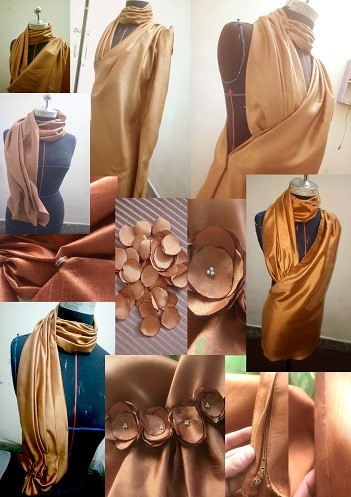Thanatophobia: Overcoming the Fear Through Fashion Design Concepts
Abstract
 Abstract Views: 0
Abstract Views: 0
The documentary film Knowing Death examines thanatophobia, or the fear of passing away. The main challenge in addressing Thanatophobia (Knowing Death) lies in its abstract nature. Furthermore, identifying death anxiety concretely and expressing it in a visual medium is a major challenge. Instead of literal representations of the subject, we’ve overcame this problem by utilizing designed images and sound metaphorically to elicit particular emotional reactions in the audience. While the topic of death anxiety is discussed through interviews, the emotional reactions reflect our own personal journey through it. This study utilized phenomenological approach combining interviews with analysis of artifacts and workshops in two phases. The study further sheds light on how clothing can address and cater to their unique requirements. In the modern world, branding and fashion have grown to be significant forces. The research adopted the Consumer Needs Model for Functional Expressive Aesthetics (FEA) as a framework for creating clothing that appeals to thanatophobic women. The study employed a sequential method, starting with an initial interview phase, followed by the creation of prototype garments, and concluding with a prototype evaluation survey administered to the research participants. phenomenological approach, combining interviews with analysis of artifacts and workshops, has been adopted.
Downloads
References
H. Feifel, “Psychology and death: Meaningful rediscovery,” Am. Psychol., vol. 45, no. 4, pp. 537–543, 1990, doi: https://doi.org/10.1037/0003-066X.45.4.537
R. Lang, “Death anxiety and the emotion-processing mind,” Psychoanal. Psychol., vol. 21, no. 1, pp. 31–35, 2004, doi: https://doi.org/10.1037/0736-9735.21.1.31
B. J. Deacon and J. Abramowitz, “Cognitive and behavioral treatments for anxiety disorders: A review of metaanalytic findings,” J. Clin. Psychol., vol. 60, no. 4, pp. 537–543, Feb. 1990, doi: https://doi.org/10.1002/jclp.10255
M. A. Cassleman-Dickson and M. L. Damhorst, “Female bicyclists and interest in dress: Validation with multiple measures,” Cloth. Text. Res. J., vol. 11, no. 4, pp. 7–17, June 1993, doi: https://doi.org/10.1177/0887302X9301100402
M. A. Casselman-Dickson and M. L. Damhorst, “Use of symbols for defining a role: Do clothes make the athlete?” Sociol. Sport. J., vol. 10, no. 4, 1993, doi: https://doi.org/10.1123/ssj.10.4.413
M. Dickson and A. Pollack, “Clothing and identity among female in-line skaters,” Cloth. Text. Res. J., vol. 18, no. 2, pp. 65–72, Mar. 2000, doi: https://doi.org/10.1177/0887302X0001800201
J. Lamb and M. Kallal, “A conceptual framework for apparel design,” Cloth. Text. Res. J., vol. 10, no. 2, pp. 42–47, Jan. 1992, doi: https://doi.org/10.1177/0887302X9201000207
E. Bye and L. Hakala, “Sailing apparel for women: A design development case study,” Cloth. Text. Res. J., vol. 23, no. 1, pp. 45–55, 2005.
M. H. Chae, C. Black, and J. Heimeyer, “Pre-purchase and post-purchase satisfaction and fashion involvement of female tennis wear consumers,” Int. J. Consum. Stud., vol. 30, no. 1, pp. 25–33, Sep. 2006, doi: https://doi.org/10.1111/j.1470-6431.2005.00434.x
A. Matthews, “Why worry? The cognitive function of anxiety,” Behav. Res. Therap., vol. 28, no. 6, pp. 455–568, 1990, https://doi.org/10.1016/0005-7967(90)90132-3
G. Mason, Life of Death: A Lifetime of Depression Leads to Happiness. CreateSpace Independent Publishers, 2012.
B. Hasenfratz, “Rethinking early cinematic adaptations: Death of poor Joe (1901),” Nineteenth Cent. Theatr. Film., vol. 42, no. 2, pp. 124–145, Oct. 2015, doi: https://doi.org/10.1177/1748372716654919
T. Burki, “The bucket list,” Lancet. Oncol., vol. 9, no. 2, pp. 103–104, Feb. 2008, doi: https://doi.org/10.1016/S1470-2045(08)70026-3
S. Holland, “Alternative women adjusting to ageing, or how to stay freaky at 50,” in Ageing and Youth Culture, A. Bennett, P. Hodkinson, Ed., London: Routledge, 2012.
J. Davis, “Punk, ageing and the expectations of adult life,” in Ageing and Youth Culture, A. Bennett, P. Hodkinson, Ed., London: Routledge, 2012, pp. 105–118.
I. Grimstad Klepp and A. Storm-Mathisen, “Reading fashion as age: Teenage girl’s and grown women’s accounts of clothing as body and social status,” Fashion. Theor., vol. 9, no. 3, pp. 323–342, Apr. 2005, doi: https://doi.org/10.2752/136270405778051329
L. H. Clarke, M. Griffin, and K. Meliha, “Bat wings, bunions, and turkey wattles: body transgressions and older women’s strategic clothing choices,” Ageing. Soc., vol. 29, no. 5, pp. 709–726, Apr. 2009. https://doi.org/10.1017/S0144686X08008283
M. Holmlund, A. Hagman, and P. Polsa, “An exploration of how mature women buy clothing: empirical insights and a model,” J. Fash. Mark. Manag., vol. 15, no. 1, pp. 108–122, Mar. 2011, doi: https://doi.org/10.1108/13612021111112377
J. Twigg, “Dress and the narration of life: Women’s reflections on clothing and age,” in Auto/Biography Yearbook 2009, BSA Auto/Biography Study Group, A. C. Sparkes, Ed., Nottingham: Russell Press, 2009, pp. 1–18.
J. Twigg, “Clothing and dementia: A neglected dimension,” J. Aging Stud., vol. 24, no. 4, pp. 223–230, Dec. 2010, doi: https://doi.org/10.1016/j.jaging.2010.05.002
C. Lerpiniere, “The Fabric snapshot- phenomenology, fashion and family memory. in IFFTI Conf. Proc., 2009, pp. 279–290.
S. Weber and C. Mitchell, Eds., Not Just Any Dress: Narratives of Memory, Body, And Identity, vol. 220, Peter Lang, 2004.
N. Richards, L. Warren, and M. Gott, “The challenge of creating ‘alternative’ images of ageing: Lessons from a project with older women,” J. Aging. Stud., vol. 26, no. 1, pp. 65–78, Jan. 2012, doi: https://doi.org/10.1016/j.jaging.2011.08.001
M. Press and P. Cooper, The Design Experience: The Role Of Design And Designers In The Twenty-First Century. Routledge, 2003.
B. Lawson, How Designers Think: The Design Process Demystified, 4th ed. Oxford: Routledge, 2006.
K. Niedderer and K. Townsend, “Designing craft research: Joining emotion and knowledge,” Des. J., vol. 17, no. 4, pp. 624–647, Apr. 2014, doi: https://doi.org/10.2752/175630614X14056185480221
J. Chapman, Emotionally Durable Design: Objects, Experiences, Empathy. London: Routledge, 2015.
B. Martin and B. Hanington, Universal Methods of Design. Beverly: Rockport Publishers, 2012.

Copyright (c) 2023 Uzma Kashif, Kashif Nawaz Khan, Najam Us Saqib

This work is licensed under a Creative Commons Attribution 4.0 International License.

This work is licensed under a Creative Commons Attribution 4.0 International License. Authors retain copyright and grant the journal right of first publication with the work simultaneously licensed under a Creative Commons Attribution (CC-BY) 4.0 License that allows others to share the work with an acknowledgement of the work’s authorship and initial publication in this journal.





